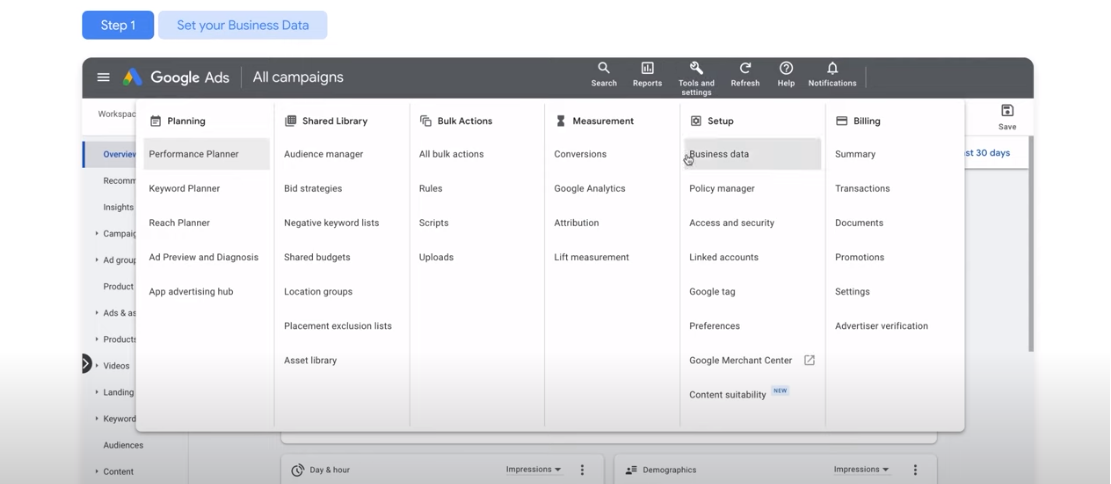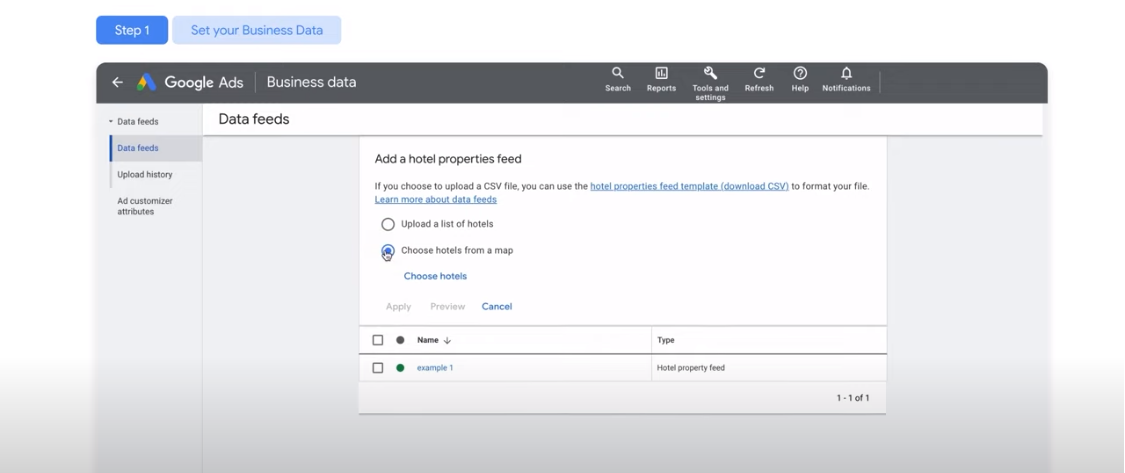Google recently provided its Performance Max best practices for advertisers in the tourism and travel industry.
The need for additional support tools outside of retail and ecommerce has been strong as Google continues to prioritize Performance Max and automation.
Google’s latest tutorials video provides key steps to setting up a successful Performance Max campaign for hotel properties.
The touted benefits of Performance Max for hotels are similar to other industries:
- The ability to reach users across the full range of Google inventory
- Expand brand reach with additional ad formats and channels
- Utilizing strategic inputs to help steer Google’s AI for maximum performance.
Step 1: Prepare the Account Settings
Before jumping into campaign creation, reviewing the Business Data settings is essential.
Navigate to “Tools & Settings” >> “Business Data” and choose the “Hotel Properties” feed.
 Image credit: Google, March 2023
Image credit: Google, March 2023This is where advertisers choose which hotels to choose from later on in the Performance Max campaign.
For marketers with few properties, use the “hotel picker” by choosing hotels from a map.
 Image credit: Google, March 2023
Image credit: Google, March 2023If over 50 properties are used, there are three options to add them to the business data:
- Create a feed using Google Maps URLs
- Use hotels in the Hotel Center Account that is linked to the Google Ads account
- Use the Google API
Step 2: Select Campaign Settings
Now, it’s time to set up the Performance Max for Hotels campaign.
When creating a new campaign, select “Sales” as the objective, then a “Purchases” conversion action from the account.
After those selections, choose “Performance Max,” which will default to the hotel selection. The travel-specific enhancement will allow advertisers to select the data feed source (from step 1).
 Image credit: Google, March 2023
Image credit: Google, March 2023One of the most critical components is selecting a bid strategy that aligns with the company’s objectives. Choose from either maximizing:
- Conversions (if all conversions are worth the same)
- Conversion value (if each conversion has a different value, such as other hotels providing different rates, etc.)
Google recommends setting a Target CPA (Cost Per Acquisition) or Target ROAS (Return On Ad Spend) from the last 30 days, comparable to other campaigns in the account with similar goals. This helps steer Google’s AI in the right direction from the start.
Finally, adjust other settings such as the ad schedule, start and end date, and budget.
Step 3: Customize Asset Groups
The first item to choose is a default logo that can be used for any hotel within the Performance Max campaign.
Each hotel that was selected in the campaign automatically becomes its own asset group (similar to an ad group for non-Performance Max campaigns).
Asset Group components
Each asset group is made up of the following:
- Website URL
- Images
- Logo(s)
- Videos
- Text headline(s)
- Text description(s)
- Call-to-action (CTA)
 Image credit: Google, March 2023
Image credit: Google, March 2023Google’s AI will automatically copy assets from the chosen website. However, advertisers must review anything selected. Advertisers can also decide on the combinations used.
Google states that if no video assets are available, they will automatically create one based on other chosen image assets.
It’s essential to review automatically chosen assets because there’s always room for a margin of error – especially if a website is not up-to-date. Be sure to check the following:
- Grammar in headlines and descriptions
- Images and video are up-to-date and high-quality
- Logos are cropped correctly
- CTAs are aligned with website goals
Utilize Audience Signals
Advertisers also can create and upload their assets for more control. While this can be a bit more manual process, it’s better for marketers who want more campaign control.
Another critical item to add to the campaign before launching is audience signals. Start by adding any first-party or customer data available to help Google’s AI find more users most likely to book immediately.
Additional audience signals recommended to add are Google’s “In-Market” segments. Similar to first-party data, these signals steer Google’s AI to more bottom-of-funnel users ready to take action.
 Image credit: Google, March 2023
Image credit: Google, March 2023Lastly, before launching, include additional assets (formerly ‘extensions‘) such as sitelinks, callouts, and calls to make the ad more prominent.
Once these items have been created and reviewed, the campaign can be launched!
Step 4: Optimize Campaign Performance
Google recommends evaluating initial campaign performance after a few weeks from launch. This is recommended because it lets Google test, optimize, and account for any potential conversion lags or delays where customers need extra time to book.
When optimizing the Performance Max for Hotels campaign, review the following regularly:
- Look for any ad or asset disapprovals that may be affecting performance
- Individual asset performance to improve creative
- Audience signals to ensure the most relevant ads are shown to the most relevant users
Google provides property-specific reporting for advertisers to help determine an indication of traveler demand across different locations. This is valuable information to marketers as it can help influence other non-Performance Max campaigns and where to shift priorities.
In addition to property-specific reporting, it supports the ability to segment by dimensions of ‘interest’ in the “Hotel” tab on the left-hand side of the interface.
 Image credit: Google, March 2023
Image credit: Google, March 2023Performance Max for Hotels uses the same Brand Safety settings at the account level, found under “Content Suitability” in the “Tools & Settings” navigation.
Summary
As Performance Max continues to mature, so does its support for other industries outside of retail and ecommerce.
This step-by-step guide to setting up a Performance Max for Hotels campaign can help alleviate optimization pain points by checking off all the necessary initial inputs.





![AI Overviews: We Reverse-Engineered Them So You Don't Have To [+ What You Need To Do Next]](https://www.searchenginejournal.com/wp-content/uploads/2025/04/sidebar1x-455.png)